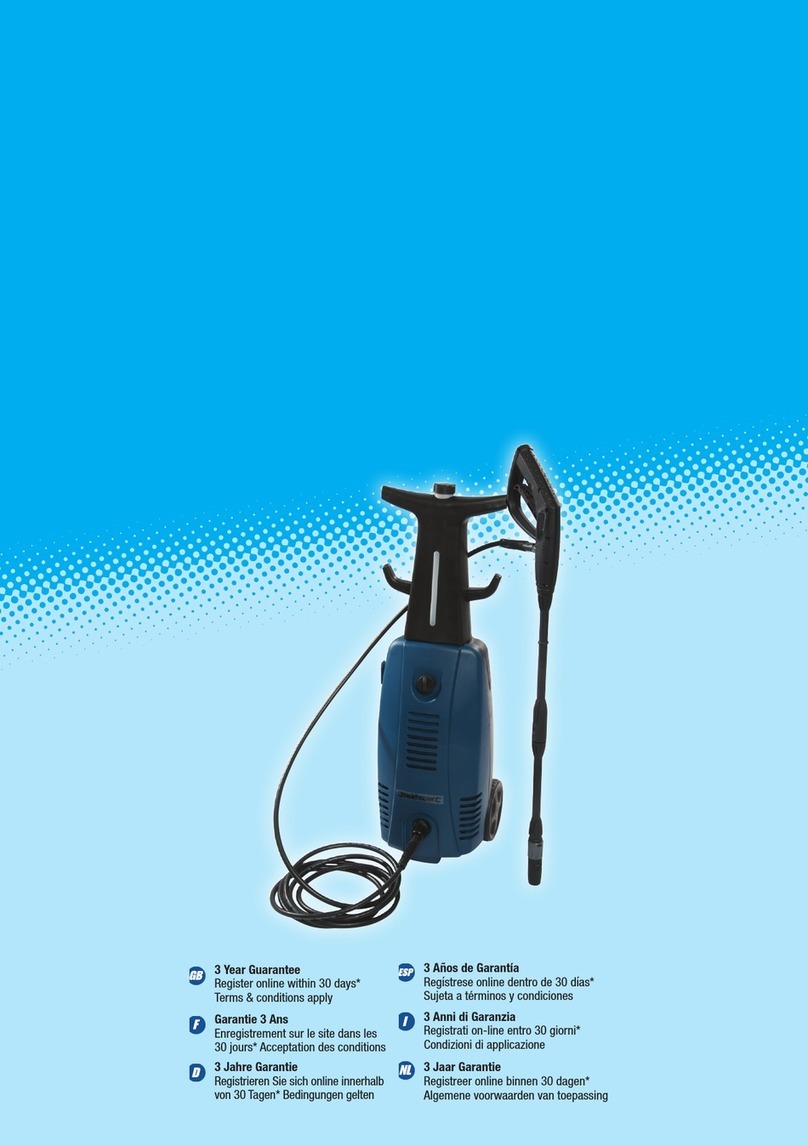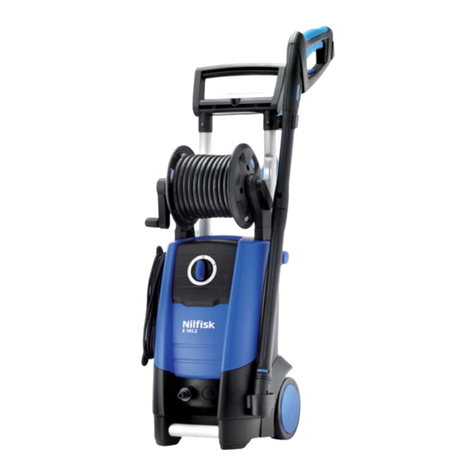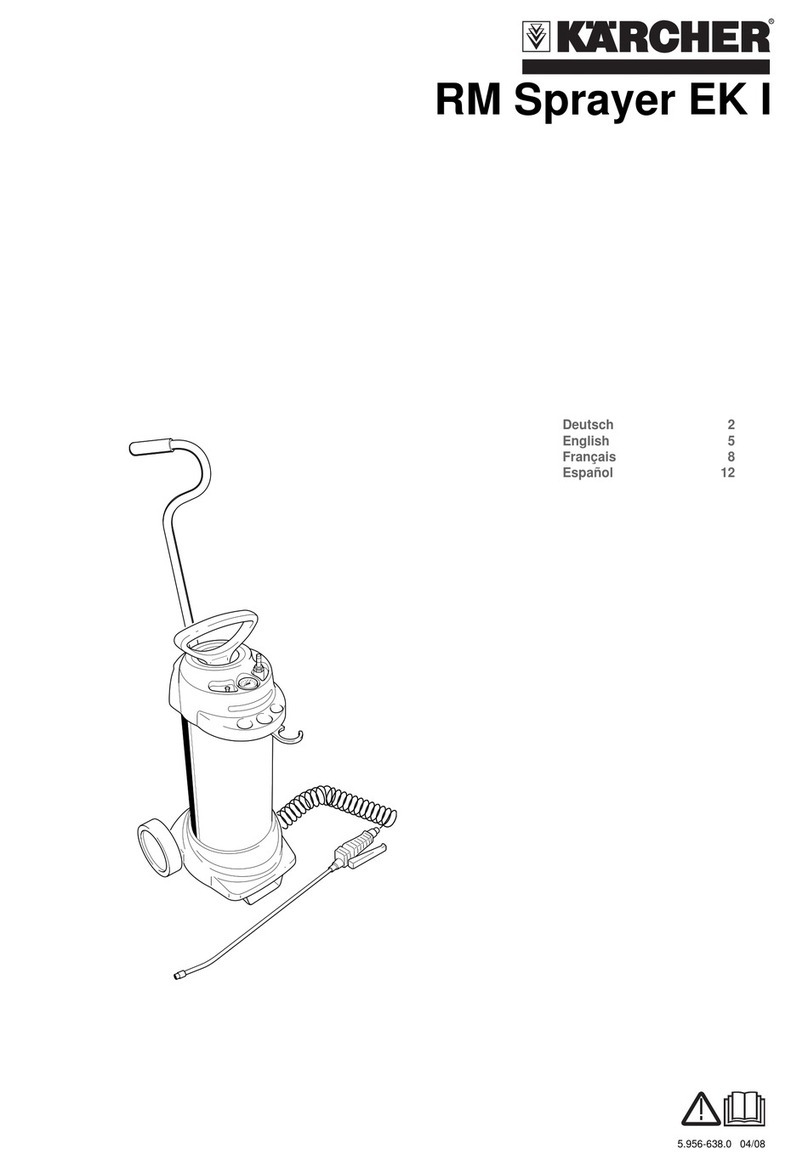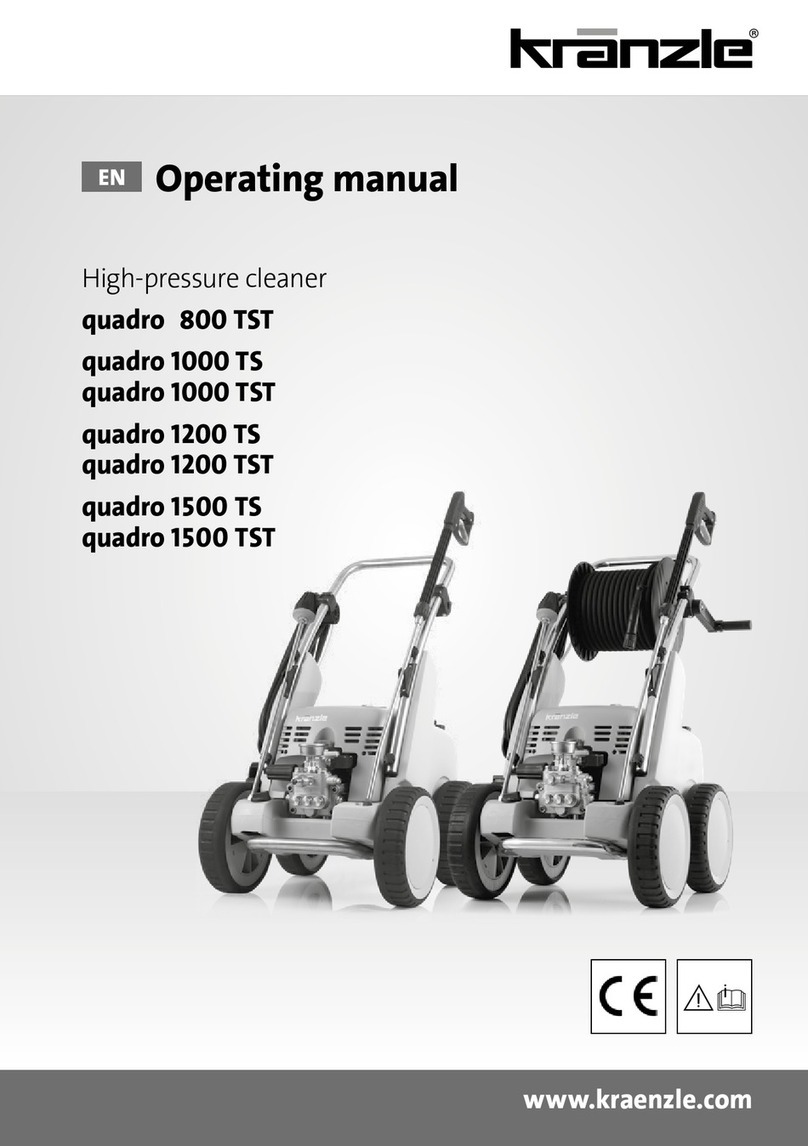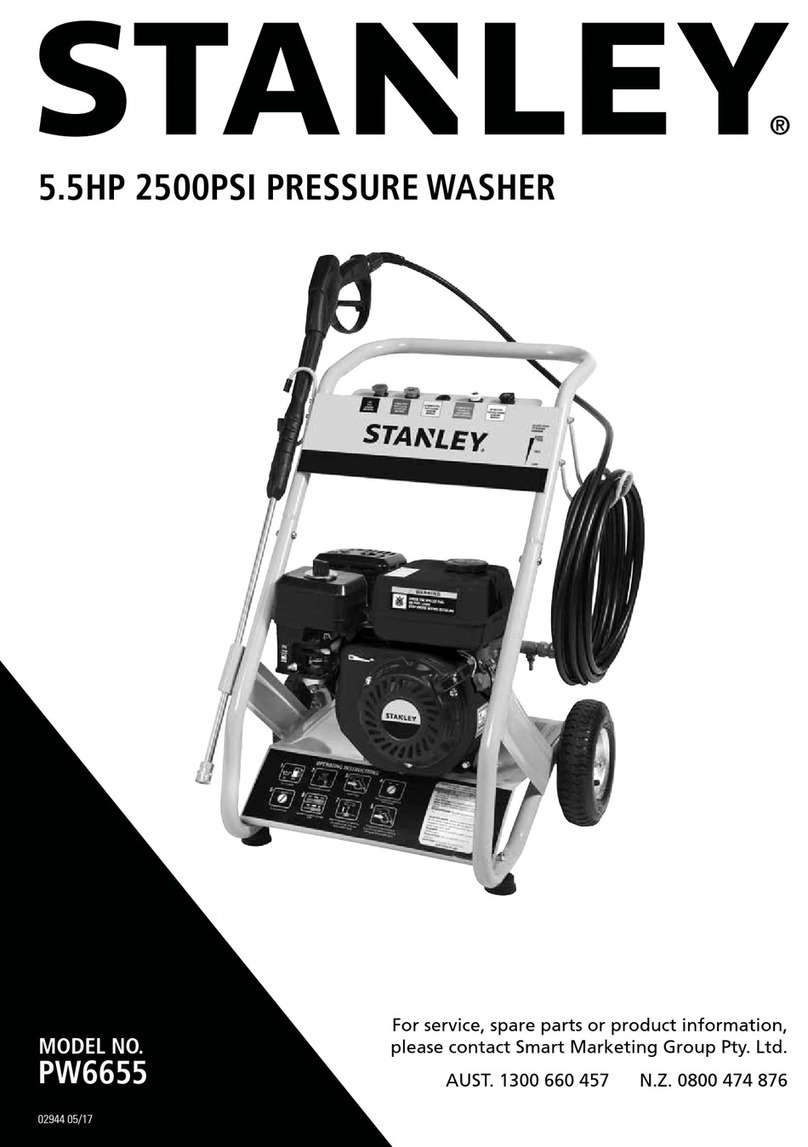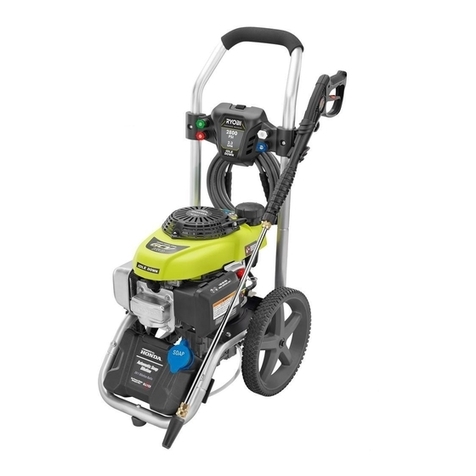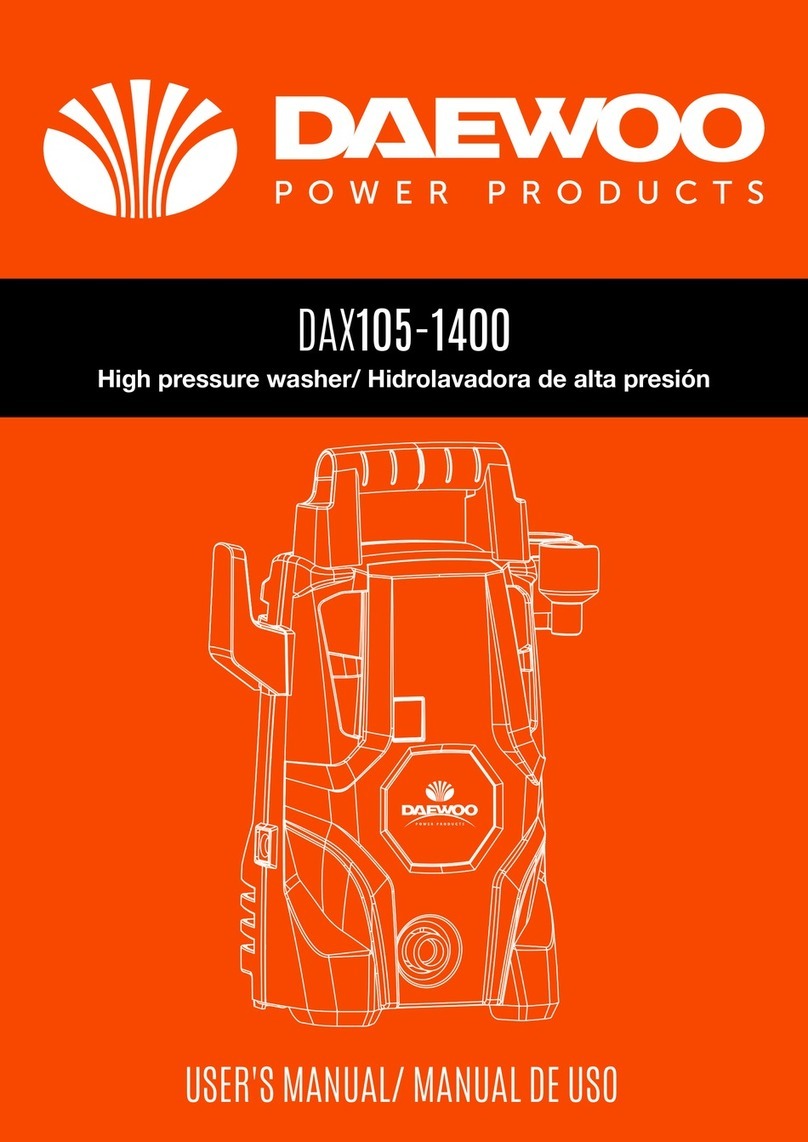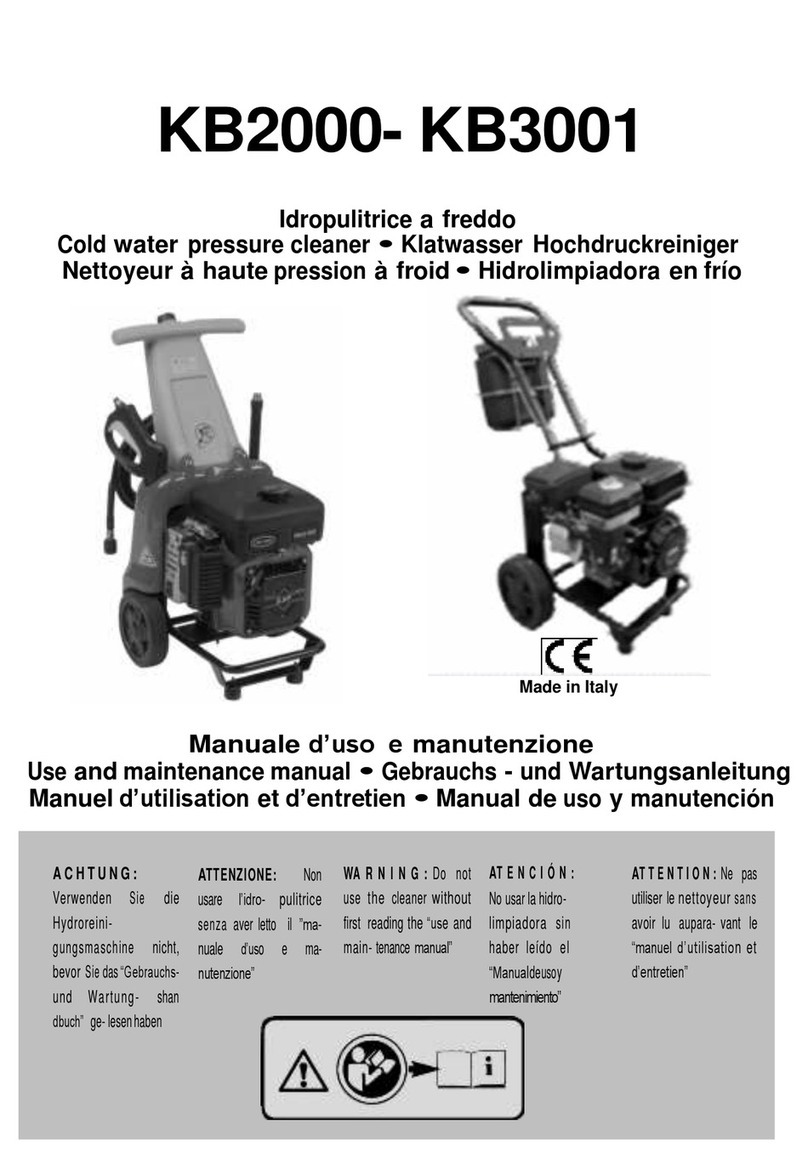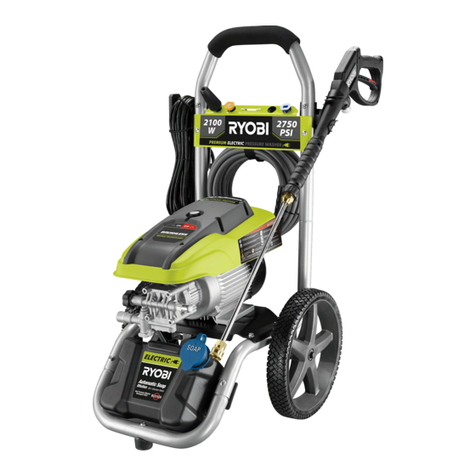Silverline 633847 User manual

Users Manual
2.5hp Petrol Driven Pressure Washer
Product Code 633847
© November 2006
• This guarantee becomes effective at the date of retail purchase.
PLEASE KEEP YOUR RECEIPT.
• If this product develops a fault within 30 days of purchase, return it to the
stockist where it was purchased, with your receipt, stating details of the fault.
You will receive a replacement or refund.
• If this product develops a fault within 1 year of purchase return it to;
Silverline Tools Service Centre
PO Box 2988
Yeovil
BA21 1WU
Include your original receipt, details of the fault, your name and address, place and
date of purchase. We do not refund carriage. All product should be in a suitably
clean and safe state for repair, and should be packaged carefully to prevent damage
or injury during transportation. We may reject unsuitable or unsafe deliveries.
• You must provide proof of purchase before any work can be carried out.
• All work will be carried out by Silverline Tools or its authorised repair agents.
• Any parts which are replaced will become the property of Silverline Tools.
• The repair or replacement of the product will not extend the period of guarantee.
• The repair or replacement of your product under guarantee provides benefits which
are additional to and do not affect your statutory rights as a consumer.
What is covered:
• The repair of the product, if found to be defective due to faulty materials or workmanship
within 1 year of purchase. If any part is not available or out of manufacture,
Silverline Tools will replace it with a functional replacement part.
• Use of the product in the UK.
What is not covered:
Silverline Tools does not guarantee repairs required as a result of:
• Normal wear and tear Eg blades, brushes, belts, bulbs, batteries etc.
• Accidental damage, faults caused by negligent use or care,
misuse, neglect, careless operation or handling of the product.
• Use of the product for anything other than normal domestic purposes.
• Change or modification of the product in any way.
• Use of parts and accessories which are not Silverline Tools genuine components.
• Faulty installation (except installed by Silverline Tools).
• Repairs or alterations carried out by parties other than
Silverline Tools or its authorised repair agents.
Silverline Tools 1 Year Guarantee
Thankyou for choosing this product
633847_Instructions.indd 1 28/3/07 16:43:44

Introduction
This manual is an integral part of the pressure washer and should be
kept with it at all times. If the pressure washer is resold this manual
should be included in the sale.
Safety Messages
A safety message is to alert you to potential dangers that could hurt
you or others. Each safety message is preceded by one of three
words DANGER, WARNING or CAUTION.
These Words Mean
DANGER: YOU WILL BE KILLED OR SERIOUSLY INJURED IF
YOU FAIL TO FOLLOW THE INSTRUCTIONS.
WARNING: YOU CAN BE KILLED OR SERIOUSLY INJURED IF
YOU FAIL TO FOLLOW THE INSTRUCTIONS.
CAUTION: YOU CAN BE SERIOUSLY INJURED IF YOU FAIL TO
FOLLOW INSTRUCTIONS.
Each safety message tells you what the hazard is, what can
happen and what you can do to avoid and reduce injury.
There are other important messages preceded with the word
NOTICE.
NOTICE: MEANS YOUR PRESSURE WASHER OR OTHER PROPERTY
COULD BE DAMAGED IF YOU FAIL TO FOLLOW THESE
INSTRUCTIONS.
The purpose of these messages is to help prevent damage to you,
your pressure washer, other property and the environment.
General Safety Instructions
Even when used as prescribed it is not possible to eliminate all
residual risk factors. Use with caution.
Keep guards in position
• Always keep guards in position, in good working order, correctly
adjusted and aligned. Never attempt to use a power tool without
any guard supplied with it.
• Provide adequate surrounding work space and keep area well lit.
Children & Pets
• Children and pets should always be kept at a safe distance from
your work. Make your work area child-proof. Lock tools away where
children can’t get access to them.
Use the correct power tool
• Don’t force, or attempt to use a power tool for a purpose it was
not designed for. Do not use a small tool to do the job of a heavy
duty tool.
Wear correct clothing and footwear.
• Don’t wear loose clothing, neck ties or jewellery or other items
which may get caught in moving parts. Wear non-slip footwear,
cover or tie back long hair. Use safety footwear if necessary.
Protect your head
• Wear safety goggles at all times, every day glasses are not sufficient
for eye protection, as lenses are not impact resistant and could
shatter. Use an approved face mask. Hearing protection should
be used if the sound intensity level for the operator could exceed
80dB(A). Use a hard hat where there is a risk of falling objects or
striking your head on low level obstructions. Protect yourself from
vibration.
• Hand held power tools may produce vibration. Vibration can cause
disease. Gloves to keep the operator warm and dry and therefore
maintain good blood circulation in the fingers may help. This tool
has not been designed for extended or industrial operation.
Secure work
Keep your balance
• Don’t over reach; keep proper footing at all times to ensure
correct balance.
Maintain your power tool
• Keep your power tool in good working order.
Never stand on your power tool
• Standing on your power tool or its stand could cause serious injury
if the tool is tipped. Do not store materials above or near the tool so
that it is necessary to stand on the tool or its stand to reach them.
Check for damaged or missing parts.
• Before each use check if any part of the power tool is damaged or
missing, check carefully that it will operate properly and perform its
intended function. Check alignment of moving parts for binding.
Any guard or other part that is damaged should be correctly
repaired or replaced.
Check any other condition that may affect the safety of the power
tool. DO NOT USE IF DEFECTIVE.
Before operating the engine, be sure to read and familiarise yourself
with the manual to prevent personal injury and/or damage to the
product.
To prevent fire hazard and provide adequate ventilation, keep the
machine at least 1 metre away from buildings and other equipment
whilst in use.
Do not place flammable objects close to the engine.
Do not leave the engine running unattended
Always wait until the engine has come to a complete stop before
leaving it.
Product Familiarisation
Petrol Driven Pressure Washer
1. On/Off engine switch
2. Fuel Lever
3. Choke
4. Throttle Lever
5. Oil Filler
6. Air Filter
7. Fuel Tank
8. Fuel Filler Cap
9. Sediment Cup
10. Recoil Starter
11. Water Intake Connector
12. Water Outlet
13. Integral Detergent Bottle
14. Trigger
15. Trigger Safety lock
16. Lance
17. High Pressure Hose
18. Lance Holder A
19. Lance Holder B
20. Hose Carrier
21. Transit Handle
22. Nozzle Cleaning Pin
SPECIFICATION
Motor: 2.5hp (97cc) 4 stroke single
cylinder side mounted valve
Fuel: Unleaded
Oil: Regular Engine Oil
Working Bar Pressure: 110 bar
Maximum Bar Pressure: 161bar
Flow per Minute: 7 Litres
Sound Pressure: 77dB
Sound Power: 97dB
Weighted Vibration: 1.5m/s2
1
2
3
4
9
10
11
20
21
16
18
7
8
19
6
5
13
12
17
22
14
15
Fig 1
Fig 2
Fig 3 Fig 4
Fig 5
633847_Instructions.indd 2 28/3/07 16:43:47

General Product Information
PRIOR TO USE - ENGINE OPERATING INSTRUCTIONS
Pre-operation checks
Fuel Lever
• The fuel lever is located between the petrol tank and the
carburettor (see Fig 5(2). When the lever is in the ON position fuel
can flow from the tank to the carburettor. Make it a rule to switch
the fuel lever to the OFF position after stopping the engine or whilst
being stored.
Choke
• The choke provides enriched fuel mixture when starting a cold
motor. It can be opened and closed with the choke switch left for
open (direction of arrow), right for closed (See Fig 5(3),
NOTICE: Engine oil is a major factor in both engine performance
and service life. Non-detergent and 2 stroke oils will damage the
engine and are not recommended.
Oil Level
• Before each use check the oil level, with the engine stopped and on
a level surface. Use four stroke oil, or equivalent. SAE 10W - 30 is
recommended for general all temperature use.
• Unscrew the dipstick and wipe it clean with lint free cloth
(See Fig 4(5).
• Insert the dipstick in to the oil filler neck
• If oil is low fill to the top of the oil filler neck with the
recommended oil.
Fuel
• If the fuel level is low refill the tank. The filler cap (see fig 4 (8)
creates an air tight seal, and to release apply downward pressure
then twist anti clockwise. When re-positioning the cap, note the 2
pronounced lugs on the underside of the cap, which must be
aligned with the 2 slots of the tank neck, then apply downward
pressure and turn clockwise until locked.
WARNING: Petrol is extremely flammable and is potentially
explosive under certain circumstances. Refuel in a well-ventilated
area with the engine switched off. Do not smoke or allow sparks or
flames in the area where the pressure washer is refuelled or where
petrol is stored. Do not over fill and after refuelling, ensure the fuel
tank cap is properly closed and secured. Do not spill petrol, when
refuelling use a funnel. Spilled fuel or fuel vapour may ignite. If fuel
is spilled make sure that the area is dry before starting the engine.
Avoid getting petrol on your skin or breathing the vapour. KEEP
PETROL OUT OF REACH OF CHILDREN.
The pressure washer runs on unleaded petrol only. Never use stale
or contaminated petrol or oil/petrol mixture. Avoid getting dirt or
water in the petrol tank.
Fuel tank capacity: 1.4 litres
NOTICE: Some petrol brands may be blended with alcohol
or ether compound to increase the octane rating. These types of
petrol are collectively referred to as oxygenated fuels. If you are
using an oxygenated fuel the octane rating must be 86 or higher.
Oxygenated fuel may cause starting and/or performance problems.
Conventional petrol is recommended.
NOTICE: Oxygenated fuel can damage metal, paint, plastic and
rubber. Do not spill fuel when refilling the fuel tank. Damage
caused by spilled fuel is not covered under warranty it constitutes
misuse.
Preparation for Starting the Engine
NOTE: This product must only be connected to the cold water
source.
Following the correct procedure will protect the user and maximise
the life of the pressure washer.
Ensure the on/off switch on the pressure washer is in the ‘off’ position
(See Fig 3(1).
Connect the water hose to the main water supply (See Fig 3(11).
Switch on the water supply.
Pull the trigger on the lance to release (bleed) the air from the unit.
Starting the Engine
Turn the engine switch to the ON position (see fig 3 (1)
• Turn the fuel lever to the ON position.(see fig 5 (2)
• Move the choke switch to the CLOSED position (turned fully anti-
clockwise). DO NOT use the choke if the engine is warm or the air
temperature is high. (see fig 5 (3)
Move the throttle lever down SLIGHTLY towards the ‘fast’ position
(See Fig 5 (4).
• Pull the recoil starter lightly until resistance is felt then pull briskly
(See Fig5 (10).
• Once the engine has started, gradually move the choke lever (see
fig 5(3) to the OPEN position as the engine warms up. Set the
choke level in a position that allows the engine to turn over evenly.
NOTICE: Do not release the recoil starter grip allowing it to snap
back against the engine, it will break. Return the recoil starter grip
gently to prevent damage to the starter or starter housing. Allowing
the recoil starter grip to snap back constitutes misuses.
Stopping the Engine
In an emergency turn the engine switch (see fig 3 (1) to the
OFF position.
In normal circumstances proceed as follows:
• Push the throttle lever (see fig 5 (4) upwards to the ‘slow’ position
• Turn the engine switch to the OFF position.
Turn the fuel lever (see fig 5 (2) fully clockwise to the OFF position.
Switch off the water supply to the machine
Discharge any remaining water in the lance by pulling the lance
trigger
Disconnect the machine from the water supply
NEVER turn the water supply off BEFORE switching off the engine,
to prevent the pump running dry, as this will cause irreparable
damage to the machine.
NEVER disconnect the high-pressure discharge hose from the
machine while the system is still pressurised. Always follow the
above procedure.
MAINTENANCE
WARNING: Exhaust gas contains poisonous carbon monoxide.
Switch the engine off before performing any maintenance work. If the
engine must be run, ensure there is adequate ventilation.
Maintenance and adjustment are necessary to keep the pressure
washer in good working order.
• Engine oil: The engine oil level should be checked before every
use. The engine oil should be changed after the first month or 20
hours whichever is sooner. Thereafter change the oil every 6
months or 100 hours whichever is sooner.
• Air cleaner: check the air cleaner before every use. Clean the air
filter every 3 months or 50 hours whichever is sooner; If the
pressure washer is used in dusty environments clean it more
frequently.
• Sediment cup: clean the sediment cup every 3 months or 50 hours
whichever is sooner, if the pressure washer is used in dusty
environments clean it more frequently (See Fig 5 (9).
• Spark plug: Check and clean the spark plug every 6 months or
100 hours whichever is sooner.
The following servicing should only be undertaken by a suitably
qualified person with the correct equipment to do the job safely.
• Valve clearance: Valve clearance should be checked and adjusted
every year or 300 hours whichever is sooner.
• Fuel tank and strainer: The fuel tank and strainer should be
cleaned every year or 300 hours whichever is sooner.
• Fuel line: The fuel line should be checked every two years and
replaced if necessary. Always replace a cracked, leaking or other
wise damaged fuel line immediately. Never operate the pressure
washer with a damaged fuel line.
TIP. Log hours of operation to determine proper maintenance
intervals
Engine Oil Change:
• Ensure engine is warm before attempting to drain oil. This will
ensure the oil drains quickly and completely.
• Remove drain plug, sealing ring and the dipstick.
• Drain the oil.
• Reinstall drain plug and sealing ring securely.
• Refill with recommended oil and check the level.
• Reinstall the dipstick securely.
Oil capacity: 0.45 litres
CAUTION: Used motor oil can cause serious skin diseases and
potentially cancer if left in contact with skin for long periods. It
is advisable to use gloves suitable for handling used oil and to
thoroughly wash skin with soap and water if the oil comes into
contact with skin.
NOTICE: Dispose of used oil in accordance with the law. Do not
pour used oil down the drain or on to the ground. Take it in a sealed
container to a suitable disposal facility.
Air Filter Service
A dirty air filter restricts airflow to the carburettor. Service the air filter
regularly to prevent carburettor malfunction. Service more frequently
if using the pressure washer in a dusty or dirty environment.
WARNING: Do not use petrol or a flammable solvent to clean the
filter element; it could cause fire or explosion. Use only soapy water
or non-flammable solvent.
NOTICE: Never run the pressure washer without the air filter. Rapid
engine wear will occur. Running the pressure washer without an air
filter or with a dirty air filter constitutes misuse.
• Unscrew the 2 nuts securing the air filter cover and remove the
element (See Fig4(6).
• Wash the element in warm soapy water, then rinse thoroughly and
allow to dry completely.
• Soak the element in clean engine oil.
• Squeeze any excess oil from the element. (NB. The engine will
smoke on initial start up if too much oil was left in the element)
• Reinstall element and cover.
Fuel Sediment Cup
The sediment cup (see fig5 (9) prevents dirt or water in the fuel tank
from entering the carburettor. If the engine has been standing for a
long time you should clean the sediment cup.
• Turn the fuel lever (see fig 5 (2) to the OFF position.
• Remove the sediment cup and ‘O’ ring.
• Clean the sediment cup and ‘O’ ring in non-flammable or high flash
point solvent and allow to dry thoroughly.
• Reinstall sediment cup and ‘O’ ring.
• Turn the fuel lever to the ON position and check for any leaks.
Spark Plug Service
Recommended spark plugs NGK L6RTF, BM4A & BMR4A.
Ensure that the spark plug is properly gapped and free from deposits
in order for the engine to operate properly.
If the engine has been running the exhaust will be very hot. Be
careful not to touch the exhaust.
• Remove spark plug cap.
• Clean the area around the spark plug of any dirt or debris.
• Remove the spark plug with a spark plug spanner.
• Inspect the spark plug; if it is damaged in any way discard it and
use a new plug. If the plug is not damaged and is to be reused
clean it with a wire brush.
• Measure plug gap with a feeler gauge and correct the gap as
necessary by bending the electrode.
The plug gap should be: 0.60 – 0.70mm
• Check that the spark plug washer is in good condition, and thread
the spark plug back in by hand to prevent cross threading.
• Once the spark plug is seated, tighten with a spark plug spanner.
If you are reinstalling a used spark plug it should be tightened by
an eighth to a quarter turn after the plug is seated. If the plug is
new it should be tightened by a half turn after it is seated to
compress the washer.
NOTICE: The spark plug must be tightened securely. Improperly
tightened spark plugs can become very hot and can damage the
engine. Never use spark plugs with the wrong heat range. Use only
the plugs recommended in this manual or equivalent.
Transportation and Storage
• During transportation the engine switch (see fig 3 (1) and fuel valve
(see fig 5 (2) should be in the OFF position. The pressure washer
should be kept level to prevent fuel spillage. Spilled fuel or fuel
vapour may ignite.
WARNING: Contact with hot engine or exhaust system can cause
serious burns or fires. Always allow the pressure washer enough
time to cool before storing or transporting. Do not drop or knock
the pressure washer when transporting. Do not place heavy
objects on the pressure washer. Before storing the pressure
washer for extended periods be sure that the storage area is, and
will remain, free of excessive humidity and dust.
Storage service procedure
• Less than one months storage; No special preparation required.
• 1 to 2 months storage; Fill with fresh petrol and add petrol
conditioner.
• 2 months to 1 year storage; Fill with fresh petrol and add petrol
conditioner. Drain carburettor float bowl. Drain sediment cup.(see
fig 5 (9)
• 1 year plus storage; Fill with fresh petrol and add petrol conditioner.
Drain carburettor float bowl. Drain sediment cup.(see fig 5 (9)
Remove spark plug and pour a tablespoon of clean engine oil into
the cylinder. Turn the engine slowly using the pull cord (see fig 5
(10) to evenly distribute the oil. Reinstall the spark plug. Change
the engine oil. When storage period is over drain the stored petrol
into a suitable container, fill with fresh petrol before starting.
Draining the carburettor
Drain the carburettor by loosening the drain screw. Drain petrol into
a suitable container.
WARNING: Petrol is extremely flammable and is potentially
explosive under certain circumstances. Do not smoke or allow sparks
or flames in the area.
Checking the Spark Plug
Remove the spark plug cap and clean any dirt or debris from around
the plug. Remove the spark plug and install it in the spark plug cap.
Set the plugs electrode on the cylinder head. Crank the engine and
sparks should jump across the gap.
WARNING: Be sure that there is no spilled fuel around the spark
plug. Split fuel may ignite.
Check Fuel is reaching carburettor
Turn the engine switch (see fig 3 (1) to the OFF position and loosen
the drain screw at the base of the carburettor. Petrol should flow from
the drain when the engine switch is turned on.
Drain petrol into a suitable container.
WARNING: Petrol is extremely flammable and potentially explosive
under certain circumstances. Do not smoke or allow sparks or flames
in the area.
633847_Instructions.indd 3 28/3/07 16:43:48

USAGE OPERATING INSTRUCTIONS
ADDITIONAL PRESSURE WASHER SAFETY INSTRUCTIONS
Never direct the water jet at people or animals, as the water pressure
is very powerful and can cause serious injury. Avoid aiming the jet at
the pressure washer body or the power supply.
Do not use in an area where ventilation could be limited and NEVER
cover the unit while it is in use.
Always ensure the water supply is connected and the flow is
continuous into the washer when being operated. If the washer
is operated when dry, it could cause irreparable damage to the
machine.
The water supply should provide a consistent pressure throughout
the period you are using the pressure washer. Make sure that, if
the supply is shared by an appliance which could affect the water
pressure eg a washing machine which draws water on and off
periodically through its programme cycle, that the appliance is not
used whilst using the pressure washer.
Handle the lance with care, ensuring that the tip is not damaged eg
striking the ground in use.
The pressure washer should always be used in its upright position.
Pressure washers can be deceptively heavy, so take care when
lifting.
NEVER connect the pressure washer to the hot water supply, as this
will rapidly reduce the life of the pump.
It is necessary to turn on the spray lance within one or two minutes
after the machine has been switched on. Otherwise, the temperature
of the water circulating within the machine will soon rise to a critical
point and will cause internal damage.
After use, the machine should be drained of all water to reduce the
risk of corrosion.
When you have finished using the machine, use the safety lock
on the lance handle to prevent the trigger from being accidentally
activated (see fig 2 (15).
When not in use, the machine should be stored in a dry location that
will not fall below freezing point.
Avoid operating the washer when it is raining or during a
thunderstorm.
Always wear safety glasses or goggles and waterproof protective
clothing when operating the washer.
When you have finished using the pressure washer, ALWAYS use
this sequence to prepare the product for storage:
Switch off engine following the procedure detailed under ‘ Stopping
the engine”.
Turn off water supply.
Depress lance trigger to drain any water residue in the machine/
hoses.
ASSEMBLY INSTRUCTIONS
DO NOT connect the pressure washer to the water supply until you
have completed the assembly.
Tools Required
You will need a 3/16” hex key (supplied) and a 14mm spanner or an
adjustable wrench (not supplied).
Assembly
Contents for Assembly:
Top handle section
4 hex bolts
4 nuts
2 wheels
lance holder A
Handle – The top half of the handle is secured to the bottom frame
using the 2 x 46mm bolts and nuts (see fig 6&7). Insert the left and
right sections into the bottom frame section. Note: when fitting the
right hand side of the handle assembly (as viewed from the rear of
the machine), first slide the bottom lance bracket onto the bolt, then
pass the bolt through the aligned bracket and handle, then secure
with the nut.
Wheels – insert the 2 wheel axles into the left and right hand ends
of the tubular section (see figs 8&9), and secure with the 2 remaining
hex ended bolts
Connect the lance to the trigger handle by pushing the bayonet end
of the lance into the trigger handle and twist the lance 45° clockwise
to lock in position (see fig 10).
Before fitting the high pressure hose to the threaded outlet, check the
gauze filter for any obstructions.
Fit the high-pressure hose onto the threaded outlet on the back/right
hand side of the machine, ensuring that it is tightly applied.
Be careful not to cross thread when screwing the hose in place
(see fig 4(12)). The outlet is the protruding pipe closest to the
detergent feeder tube.
Before fitting the water inlet hose to the machine, check the inlet
water filter for any obstructions that would restrict the water flow to
the pump.
To attach the hose feed to the water supply will require a female 3⁄4”
push fit hose connector (not supplied).
GUIDANCE IN USE
The Lance nozzle can be adjusted between a wide fan shaped
spray, reducing to a fierce narrow spray. This provides you with great
versatility over the jet strength to suit the surface type and the depth
of cleaning required.
When you are ready to use the washer, it is advisable to adjust the
nozzle to the wide spray position initially (with the lance pointing
away from you, turn the lance nozzle clockwise). You can then
increase the water pressure as required by a combination of moving
the lance head closer to the surface, and reducing the arc of the
water spray (turning the lance nozzle anti-clockwise). If you are
unsure of the durability of the surface to be cleaned, then use the
combination of adjustments to distance and spray arc very carefully
to maximise the efficiency of the machine without the risk of damage
to the surface you are cleaning.
It is recommended that positioning the lance at a 45° angle to the
surface to be cleaned will give you maximum control and the greatest
cleaning efficiency. When cleaning a vertical surface using detergent,
start from the bottom and work your way up, as this will minimise
the risk of ‘streak’ lines on the surface. When using detergent, test
an inconspicuous area first to ensure that the detergent will not
adversely affect the surface to be cleaned.
Using Detergent with the Lance
Push nozzle away from the lance head to engage soap dispenser
and reverse the procedure to stop the soap flowing.
A few seconds are then needed to allow detergent to flow. Note: The
detergent will only flow when the nozzle is set for a slow water flow.
MAINTENANCE
It is highly recommended that you clean the nozzle with the cleaning
pin (item 22 in ‘introduction’) after each use.
Fig 6
Fig 8
Fig 9
Fig 10
Fig 7
633847_Instructions.indd 4 28/3/07 16:43:56

TROUBLESHOOTING CHART
Symptom Possible Cause (s) Corrective Action
Pressure Washer does
not start
Unit is pressurised
Is there sufficient fuel/oil in the engine?
Possible spark plug failure
Squeeze trigger on the gun
Add fuel/oil as required.
Clean the spark plug and check spark plug gap.
Replace the spark plug.
Fuel starvation Check the fuel sediment cap for any blockage.
Drain fuel system and refill.
Pump pressure is low Water inlet filter is clogged
Check for water leaks
Clean filter
Check and tighten all connections
Fluctuating ‘Pulsing’
Pressure
Pump sucking in air
Clogged Nozzle
Check and tighten all connections, and make
sure the lance has been ‘bled’ - see ‘Operating
Instructions’
Use cleaning pin (see item 22 in ‘introduction’)
No detergent being
ejected
Lance nozzle not in wide
spray/low pressure position
Adjust lance nozzle - see ‘Guidance in use’
The Engine will not start
633847_Instructions.indd 5 28/3/07 16:43:57
Other manuals for 633847
1
Table of contents
Other Silverline Pressure Washer manuals
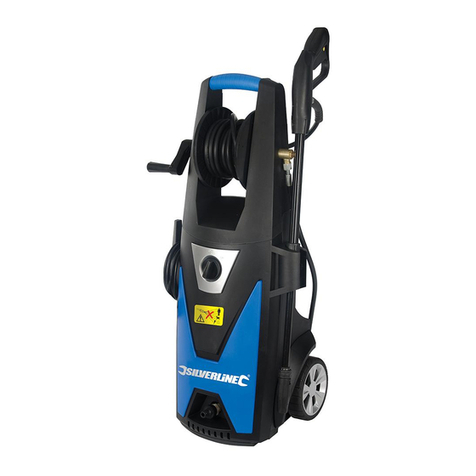
Silverline
Silverline 102377 User manual

Silverline
Silverline 633847 User manual
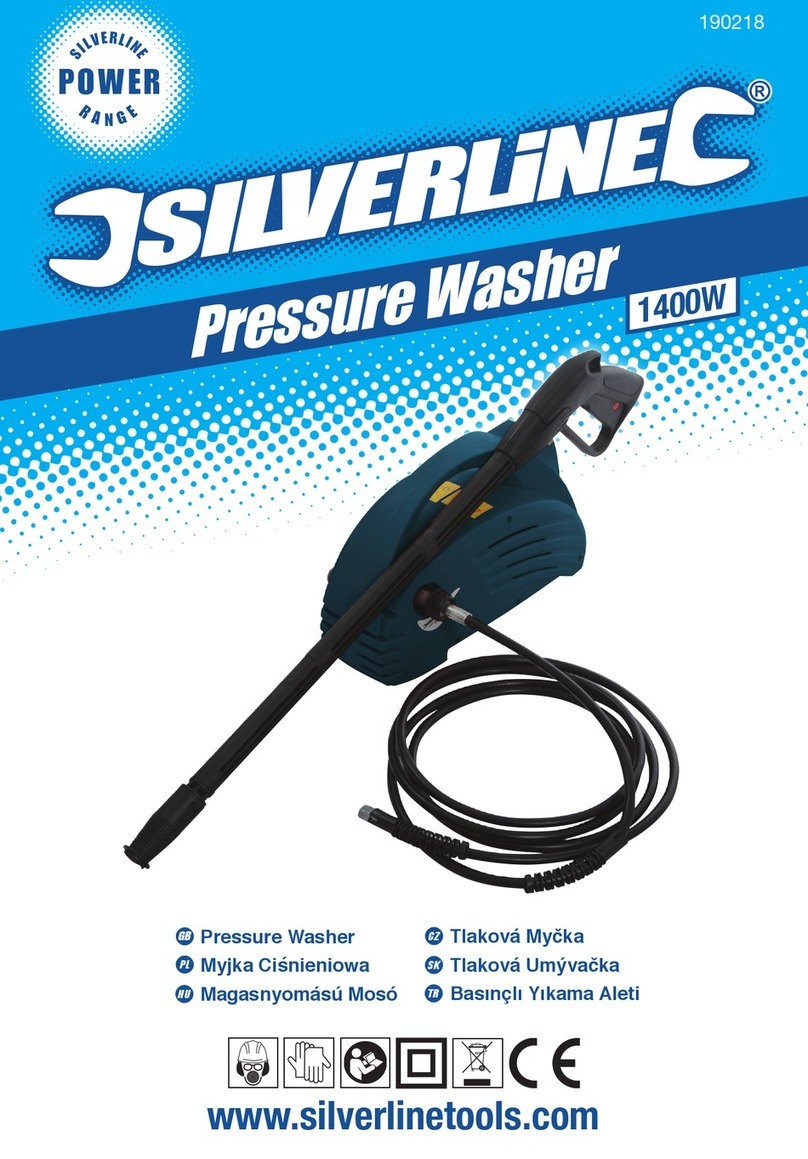
Silverline
Silverline 1400W Pressure Washer User manual

Silverline
Silverline 1400W Pressure Washer User manual
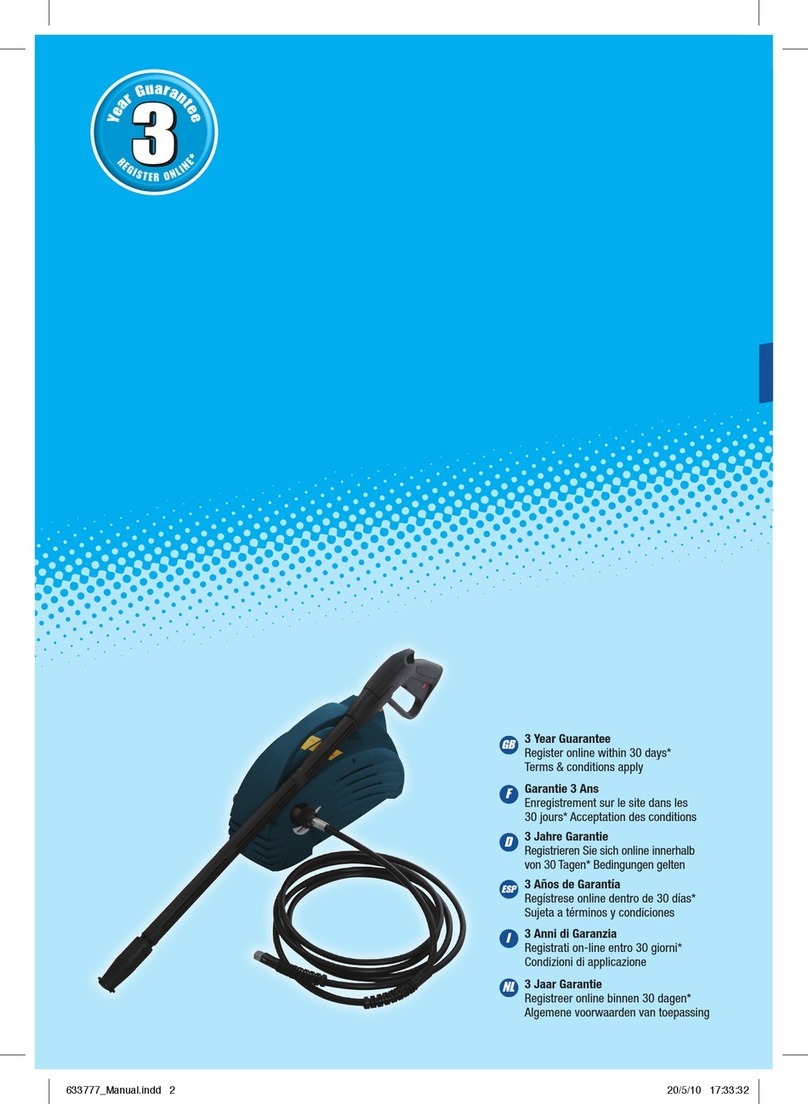
Silverline
Silverline POWER 633777 User manual
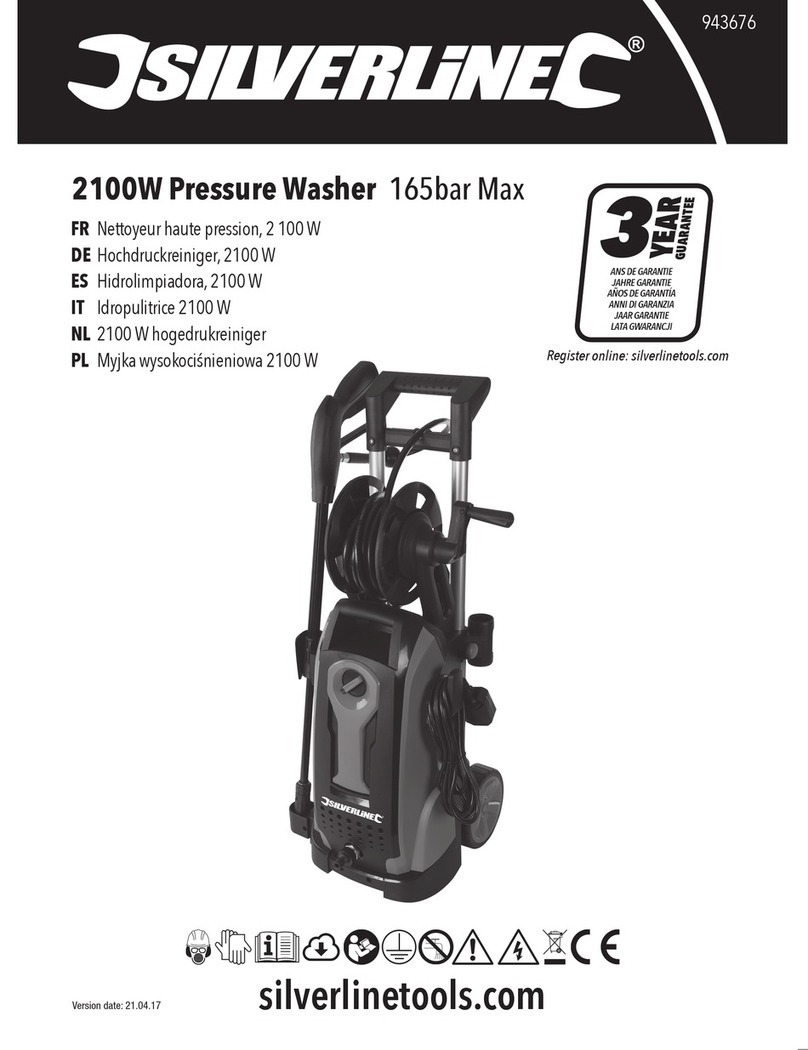
Silverline
Silverline 943676 User manual
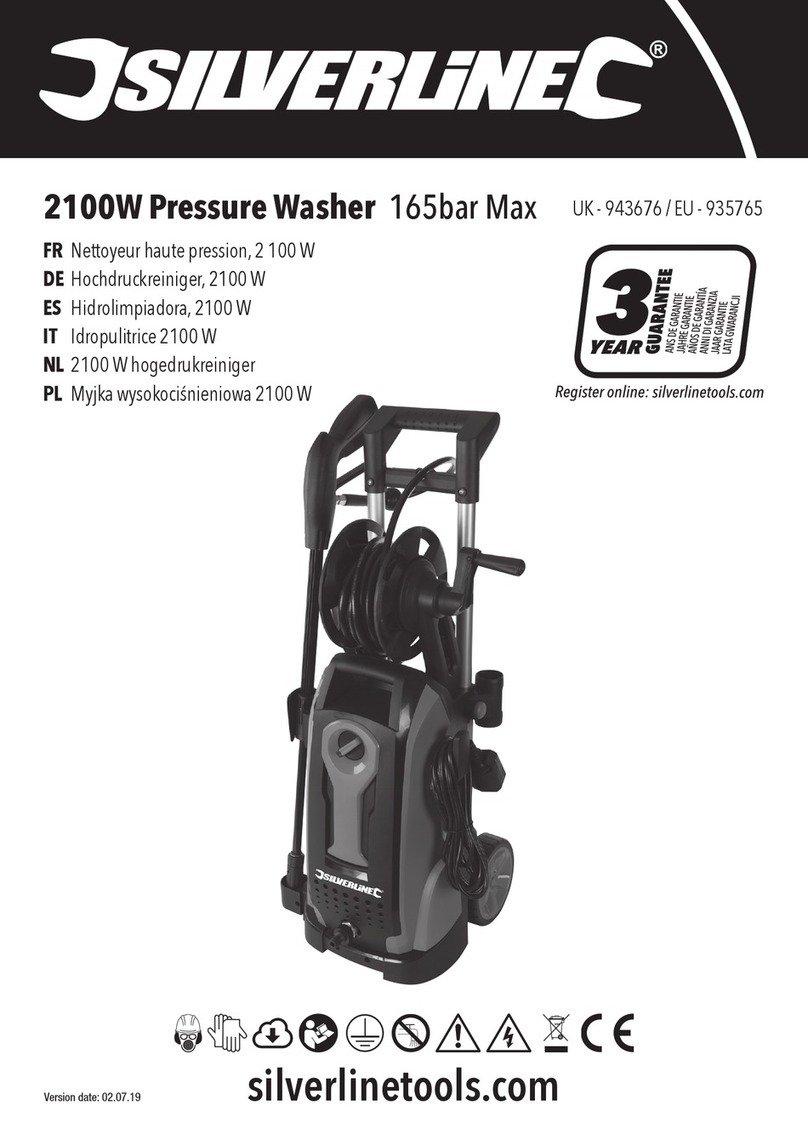
Silverline
Silverline 935765 User manual
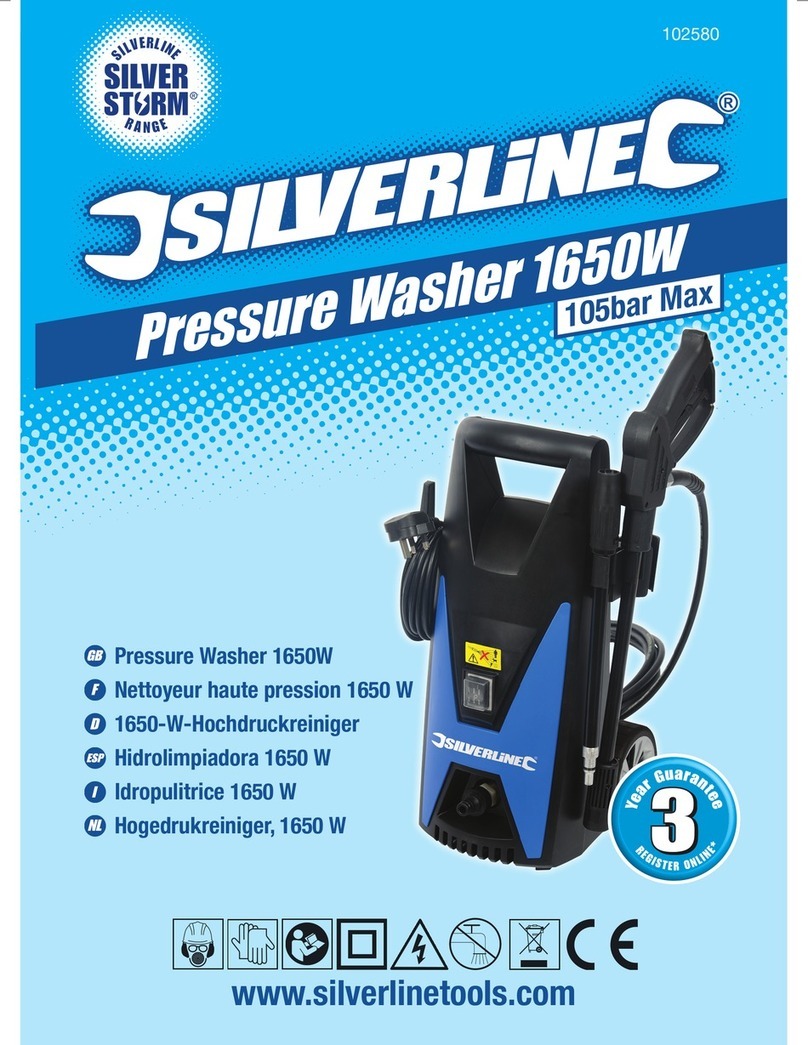
Silverline
Silverline 102580 User manual

Silverline
Silverline 389431 User manual
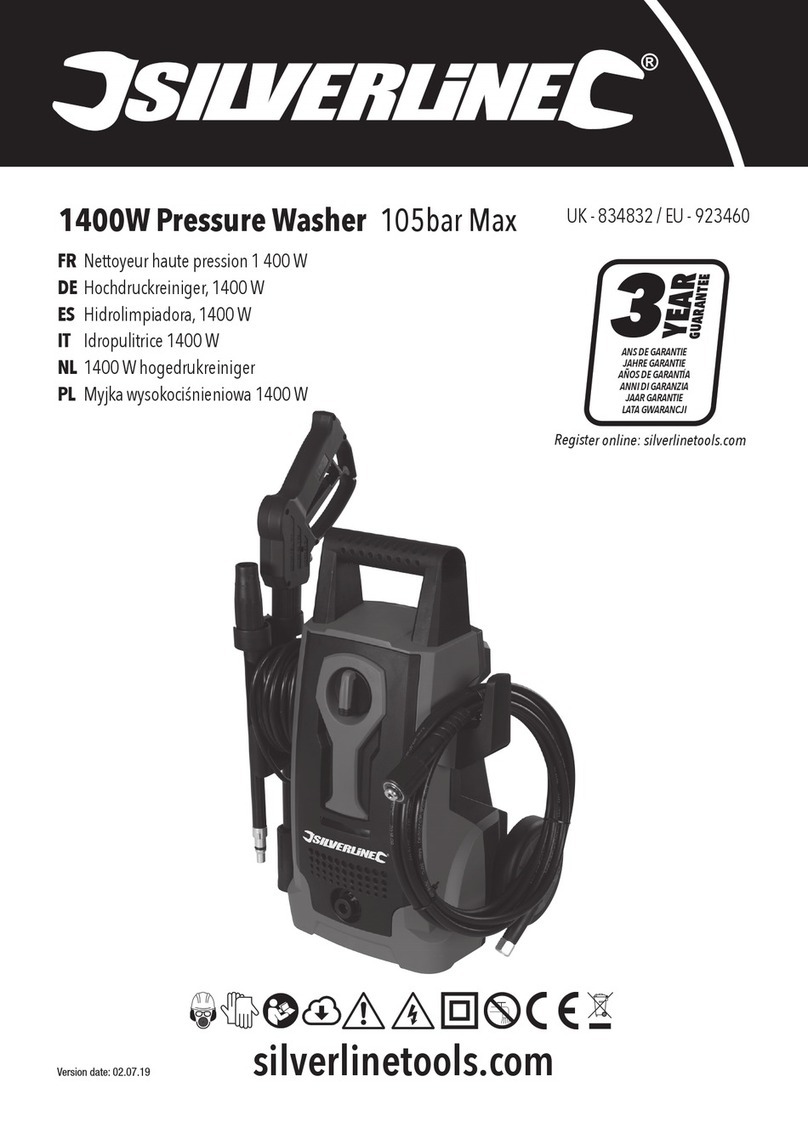
Silverline
Silverline 834832 User manual
